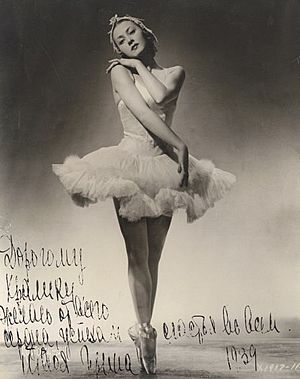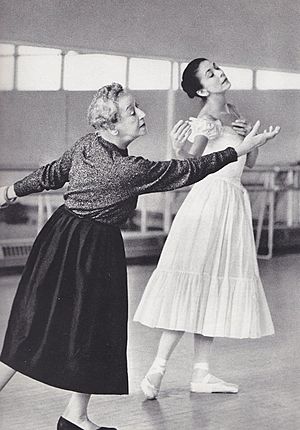Ballet dancer facts for kids
A ballerina is a special name for a female ballet dancer. This title was once given only to the very best female dancers. They were often the main dancers in a classical ballet company. The top female dancer was called the prima ballerina.
Today, the word 'ballerina' is not used as much. Now, both male and female lead dancers are usually called 'Principal dancers' or simply 'ballet dancers'. Dancers in a company have different ranks, like a team, and are paid based on their level. They usually start in smaller roles and work their way up.
Here are some common ranks in a modern dance company:
- Corps de ballet: These dancers perform together in groups and do not have individual named parts.
- Coryphées: These are minor soloists, meaning they dance small solo parts.
- Principal character artists: These dancers perform roles that involve a lot of acting.
- Second soloists: Dancers who take on named solo roles.
- First soloists: A step up from second soloists, with more important solo parts.
- Principal dancers: These are the lead dancers. If they are female, they are like the 'ballerinas' of the past.
- Principal guest artist: A famous dancer from another company who performs with this company for a short time.
A ballet dancer is anyone who practices classical ballet, whether male or female. Dancers follow a strict system and have different roles based on gender. They train for many years to learn the right techniques. This helps them join professional dance companies. Ballet dancers face a high risk of injury because ballet is very demanding on their bodies.
Contents
How Ballet Dancers Train
Ballet dancers often start training very young. Girls might begin between ages 2-4, and boys between 5-7. This early start is important if they want to dance professionally. Even after joining a company, training never stops. Dancers must attend ballet class six days a week. This keeps them fit and ready to perform. Ballet is a very strict art form, so dancers must be strong, athletic, and very flexible.
Ballet classes usually begin at the barre. This is a wooden rail along the studio walls. Dancers hold the barre for support during warm-up exercises. Barre work helps warm up the body and stretch muscles. After the barre, dancers move to the center of the room. Here, they do exercises without support. Center work starts slowly, then moves to faster, bigger movements. They finish with large leaps across the floor, called grande allegro.
After center work, female dancers practice pointe work. This means dancing on their toes in special pointe shoes. Male dancers focus on jumps and turns. Sometimes, dancers also practice partner work together.
Common Ballet Injuries
Ballet dancers can get injured easily. This is because they put a lot of strain on their bodies. Their goal is to make difficult moves look easy. Starting training too early, especially before age ten, can increase injury risk. However, many dancers do start around 6 to 8 years old.
A dancer's upper body can get hurt. This is because ballet moves often involve bending their backs and hips. Back bends can pinch the spine, leading to spasms or pinched nerves. Holding legs high and turned out can damage hips. This might cause strains, small bone breaks, or bone density loss.
Injuries are common because ballet puts the body in unusual positions. For example, in first position, heels are together and toes point out. This "turns out" the legs. First position can strain the knees. Knee injuries like tears or dislocations are common if knees slide forward.
Dancers' feet are also prone to breaks and damage. Landing from jumps and dancing on pointe can break bones. It can also weaken ankles. Tendonitis is common for female dancers. This is because pointe work is hard on their ankles. Landing jumps wrongly can also cause shin splints. This is when muscles separate from the bone.
During class, teachers help dancers correct bad habits. This helps prevent injuries. Proper training can lower the risk of getting hurt. Many dancers also do other exercises like Pilates, Yoga, or swimming. These activities build strength and stamina. Even with care, injuries can happen during performances. Many injuries may not appear until later in a dancer's life. This is after many years of continuous strain.
Titles for Dancers
Ballet has traditional titles for male and female dancers. In French, a male dancer is a danseur. A female dancer is a danseuse. In Italian, a ballerina is a female lead dancer. The male equivalent is ballerino. The general Italian terms are danzatore for male and danzatrice for female.
Until the 1950s, 'ballerina' meant a top female dancer. She had to be famous beyond her own company. Other female dancers were called danseuses or ballet dancers. 'Ballerina' was a high honor, like 'diva' in opera. The male version was danseur noble. After the 1960s, 'ballerina' became a general term for any female ballet dancer.
Sometimes, 'ballerina' is still used for a very skilled female dancer. In these cases, it means she has amazing talent and achievements.
Dancer Ranks Over Time
Many people use 'ballerina' to describe any female ballet student. But it was once a rank for only the most special female soloists. Like a 'diva' in opera, a ballerina was the top star of the dance world.
Old Ranks for Women
In the past, the ranks for women, from highest to lowest, were:
- Prima ballerina assoluta (Italy)
- Prima ballerina, premier sujet or première danseuse
- Sujet
- Coryphée
- Corps de ballet
Old Ranks for Men
For men, the ranks used to be:
- Premier danseur noble
- Premier danseur
- Danseur
- Sujet
- Coryphée
- Corps de ballet
- Ballerino
Ranks Today
Ballet companies still rank their dancers. But most now use a system that is the same for both sexes. Few companies have just one top dancer. Most large companies have several lead dancers of each sex. They are called principal dancer or étoile. This shows their high status. The most common ranks in English are:
- Principal Dancer
- Soloist (or First Soloist)
- Demi-Soloist (or Second Soloist)
- Corps de Ballet
- Apprentice
The title of prima ballerina assoluta is rarely used today. It is mostly given as a sign of respect. It honors a famous dancer who has had a very important career. It is seen as an honor, not an active rank.
Dancers called "guest artists" are usually high-ranking dancers from their own company. They are invited to dance lead roles with other ballet companies around the world.
Prima ballerina assoluta
The title prima ballerina assoluta came from early Romantic ballet masters in Italy. It was given to a ballerina who was incredibly talented. She was considered better than other leading ballerinas. This title is very rare now. When it is used, it is usually to honor a dancer's amazing career. It is seen as a special award, not a regular rank.
Famous Ballet Dancers
- Margot Fonteyn
- Tamara Karsavina
- Mikhail Baryshnikov
- Anna Pavlova
- Rudolf Nureyev
- George Balanchine
- Vaslav Nijinsky
- Misty Copeland
- Natalia Makarova
- Diana Vishneva
- Carlos Acosta
Images for kids
-
Pierina Legnani (left) and Olga Preobrajenskaya (right) in Le Corsaire, 1899. Legnani was the first dancer to be called Prima ballerina assoluta.
-
A dancer performing Coppélia in 2010.
See also
 In Spanish: Bailarín de ballet para niños
In Spanish: Bailarín de ballet para niños







